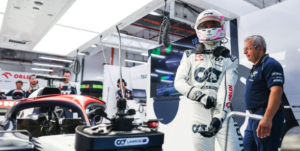The electrifying atmosphere of the Formula One (F1) race in Singapore is an unforgettable experience for anyone living in the city. As the streets of Marina Bay were transformed into a dynamic race circuit under the cloak of night, the roar of F1 engines reverberated amongst the skyscrapers of the Central Business District, captivating both motorsport enthusiasts and curious onlookers alike.

As yet another exhilarating F1 weekend drew to a close in Singapore, the scene of workers dismantling the rows of lights and spectator seats outside the EdgeConneX downtown office served as a reminder of the indispensable role that data plays in the world of F1. While sports across the board increasingly rely on data analytics, none have forged a symbiotic relationship with data quite like the high-octane world of F1 racing. I picked this picture as Liam Lawson is a rookie New Zealand driver in his 3rd race, scoring points!! Great stuff Liam and New Zealand!
Importance of Data in F1
In the fast-paced world of Formula One, where every millisecond counts, teams leave no stone unturned in their quest for optimal performance. Extensive data collection takes center stage during practice sessions and races, serving as the lifeblood for analyzing and fine-tuning every intricate aspect of the car’s performance. Beyond performance, data also plays an instrumental role in shaping race strategies and enabling real-time adaptability, all while ensuring driver safety remains paramount.
To paint a clearer picture of the data deluge, consider this: F1 cars are equipped with an astonishing array of more than 300 sensors that generate more than 1 million telemetry data points per second. This staggering volume of information is seamlessly relayed to the team’s engineers stationed in the pit garage, as well as to the F1 race control. Yet amidst the relentless torrent of data, one question arises: How is this vast amount of information stored and processed at lightning speed?
Getting an Edge Over the Competition
The invisible hands facilitating all these data transactions are, of course, data centers that provide IT infrastructure, access to high bandwidth connectivity and support specifically tailored to the dynamic demands of the sport.
Edge data centers, specifically, play a crucial role in supporting F1 teams by providing not only the low latency connectivity and cloud access required to transmit data but also localized computing and data processing capabilities closer to the racetrack and team operations.
Edge data centers offer several advantages for F1 teams, especially given the high-performance demands of F1 racing.
- Low Latency: Edge data centers being near the race circuit reduces latency in data transmission. In F1, where real-time data is critical for making split-second decisions, low latency is essential.
- Scalability: Edge data centers can be scaled up or down to meet the specific needs of each race circuit. F1 teams deal with varying data loads and computing requirements from one circuit to another, and edge data centres offer flexibility by allowing teams to tailor their IT infrastructure to the demands of each race location.
- Reduced Network Congestion: By processing data locally at the edge, F1 teams can reduce the load on their wide-area networks. This is particularly important when considering the high volume of data generated during an F1 race. Reduced network congestion ensures that critical data reaches the right people without bottlenecks.
Looking Towards the Future

Second-screen apps are also increasingly being used to provide additional insights while watching races on television and are equipped with interactive features that allow fans to dive deeper into the race.
For F1 to deliver a real-time interactive experience for fans, low latency is non-negotiable, or else the fan experience becomes severely compromised. With higher-quality video broadcasts, more advanced graphics, and immersive experiences through Virtual Reality (VR) and Augmented Reality (AR), broadcasters and content delivery platforms require high-quality data center infrastructure to support the needs of F1 fans.
Similarly, F1 teams are likely to see an explosion in the volume of data generated by F1 cars thanks to advancements in technology that allow for a higher frequency of data collection. With F1 cars set to become more data-rich and the sport’s global appeal expanding, data centers will continue to serve as the beating heart of the racing and viewing experience in F1.
